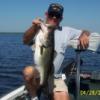Some facts about golden algae: There are over 300 species of golden algae. The below is of concern.
The golden alga, Prymnesium parvum, is a tiny, one-celled aquatic organism about the size of a human blood cell. The alga is motile with two tails called flagella that help it to move through the water in lakes and ponds. A single drop of lake water may contain well over 2,000 cells of golden alga. Biologists suspect that golden alga is relatively new to Arizona and they consider it a nuisance invasive species.
Golden alga releases unique toxins that affect gill-breathing aquatic organisms (mainly fish and clams). The alga is a rapid growing and resilient algae species, out-competing other algae for nutrients and thriving in a wide variety of environmental conditions. In a bloom situation (a bloom is an explosive increase in the population of one or several species of algae), enough toxins are released into the water to kill fish and other gill breathers that come in contact with it. The toxins cause fish gills to bleed internally, and lose their ability to exchange water and absorb oxygen. Fish then die of asphyxiation (lack of oxygen).
Where does it occur?
Golden alga was first identified in Arizona in April 2005. To date, golden alga has been confirmed in various public and private waters in the greater Phoenix area and in three reservoirs on the Tonto National Forest.
Four Urban Fishing Program waters have been infested: Water Ranch Lake (Gilbert), and Alvord Lake at Cesar Chavez Park, Cortez Lake and Desert West Lake in Phoenix. It has been found in Saguaro Lake, Canyon Lake and Apache Lake.
Golden alga was first discovered in the United States in Texas in 1985. Since then, it has caused fish kills in five major river systems and over 25 lakes or reservoirs in Texas. Texas officials have estimated the direct economic loss of over 18 million fish due to golden alga as $7 million. This toxin producing algae has now been documented from 12 states ranging from North Carolina to Georgia to Wyoming to Arizona.
It was a scene Jay Stafford hopes to never see again. In early June 2002, the Colorado Department of Wildlife fisheries biologist was called out to Prewitt Reservoir, a popular 2,500-acre fishing lake in that state's northeastern region. Anglers were reporting dead walleyes, sauger, and other fish washing up on shore. By the time I got there, it appeared to be a complete fish kill, says Stafford. There were windrows of dead fish as far as the eye could see, 20 to 30 feet wide.
The culprit was a deadly organism called golden algae. First identified in Israel, it showed up in 2000 in Texas, where it has damaged fisheries throughout the state. In Iowa, where it has since spread, golden algae has wiped out entire fish populations. The algae secretes a potent neurotoxin that quickly enters the bloodstream of fish to cause asphyxiation. No one is sure how it spreads, though boat bilges, bait buckets, livewells, and bird plumage are all suspects.
Since these articles it has been confirmed to be even more widespread.












